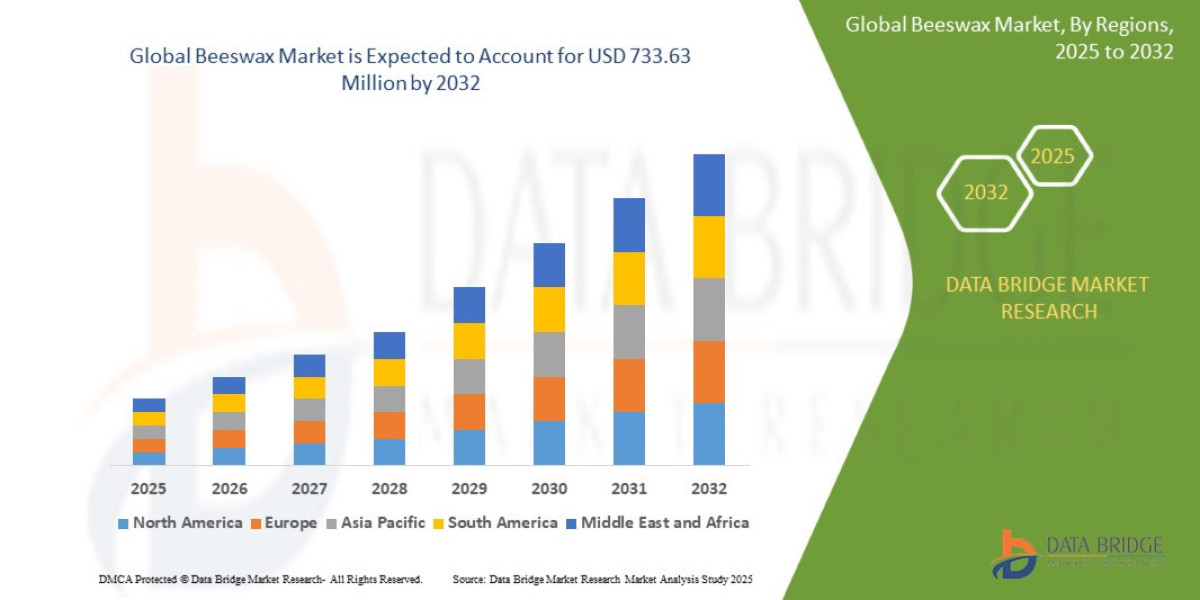Executive Summary
- The global beeswax market was valued at USD 579.14 million in 2024 and is expected to reach USD 733.63 million by 2032
- During the forecast period of 2025 to 2032 the market is likely to grow at a CAGR of 3.00%,
Market Overview
Definition and Scope
The Beeswax Market includes the trade and processing of raw beeswax, which is collected from honeycombs after honey extraction, and its refined forms. The core product segments are defined by processing:
Yellow Beeswax (Raw/Crude): Least processed, retaining its natural color, aroma, and functional properties. Used primarily in candle making and industrial applications.
White Beeswax (Bleached/Refined): Chemically or physically bleached (usually by activated carbon or UV light) to remove color and odor. This is the premium, highest-value grade, essential for cosmetics, personal care, and pharmaceuticals.
Key Market Segmentation
Cosmetics & Personal Care (Largest & Highest Value): Dominant application due to its properties as a thickener, emulsifier, and emollient. Primary use in lip balms, lotions, creams, and makeup (e.g., mascara).
Pharmaceuticals: Used as a glazing agent for tablets, a base for ointments, and in advanced applications like sustained-release coatings and micro-encapsulation. Requires the highest purity grade (often certified according to pharmacopoeial standards).
Candles: Premium market segment focused on natural, slow-burning candles.
Industrial Applications: Used in polishes, leather treatments, mold-making, and specialized lubricants.
Food & Beverage: Used sparingly as a surface-glazing agent for confectionery (E901) and fruits.
Market Drivers
The Clean Label Movement: Consumer rejection of synthetic, petroleum-derived ingredients drives demand for natural waxes, positioning beeswax as a primary alternative to mineral oil and paraffin.
Demand for Organic Cosmetics: The proliferation of certified organic skincare and makeup products necessitates the use of certified organic beeswax, which commands a significant price premium.
Growth in Apiculture-Derived Ingredients: The broader focus on beneficial bee products (propolis, royal jelly) enhances the perception and marketability of beeswax.
Functional Superiority: Beeswax provides superior texture, consistency, and stability in topical formulations compared to many plant-based or synthetic waxes.
Current Dynamics
The market operates under a fundamental tension: high, steady demand meets an unpredictable, inelastic supply. This asymmetry means that pricing is highly sensitive to annual honey harvests and weather patterns. Furthermore, the complexity of the global supply chain, which often passes from small, decentralized beekeepers through multiple aggregators before reaching centralized refiners, creates fertile ground for quality issues and illegal adulteration.
Market Size & Forecast
- The global beeswax market was valued at USD 579.14 million in 2024 and is expected to reach USD 733.63 million by 2032
- During the forecast period of 2025 to 2032 the market is likely to grow at a CAGR of 3.00%,
For More Information Visit https://www.databridgemarketresearch.com/reports/global-beeswax-market
Key Trends & Innovations
1. Advanced Purity and Adulteration Detection
The high price of pure beeswax makes it a frequent target for adulteration, primarily by blending with cheaper paraffin, microcrystalline wax, or animal fats.
Technological Countermeasures: Innovation is focused on advanced analytical techniques, including Gas Chromatography-Mass Spectrometry (GC-MS) and Fourier-Transform Infrared Spectroscopy (FTIR), used to detect characteristic marker compounds (like synthetic esters) not present in natural beeswax.
Traceability Systems: Adoption of blockchain or digital ledger technology to track certified batches from the apiary through refining, ensuring verifiable origin and quality.
2. Focus on Sustainability and Ethical Sourcing
The health of the global honeybee population is now a key factor in supply risk management. Consumers demand proof of ethical beekeeping practices that prioritize bee health over maximum honey/wax yield.
Certified Organic and Fair Trade: Programs certifying beeswax are increasingly sought after by CPG firms to meet corporate social responsibility (CSR) goals and attract premium consumer segments.
Beyond Beeswax: Increased R&D into functionally similar plant-based waxes (e.g., Carnauba, Candelilla, Sunflower Wax) as partial substitutes to mitigate supply risk. However, these rarely match the functional versatility of beeswax.
3. Pharmaceutical Grade Evolution
In the pharmaceutical sector, the trend is toward highly standardized, functional grades.
Sustained Release Matrices: Research utilizes beeswax as an inert, biocompatible matrix to control the release kinetics of oral drugs.
Micro-encapsulation: Using beeswax to micro-encapsulate sensitive ingredients, protecting them from oxidation and degradation during storage. This requires ultra-high purity and consistency in melting point.
4. Direct-to-Consumer (D2C) Apiculture Brands
A growing trend involves small, local beekeeping operations creating D2C brands that leverage the narrative of local sourcing, transparency, and raw quality. These brands command extreme price premiums but occupy a niche outside the high-volume industrial market.
Competitive Landscape
The competitive structure of the Beeswax Market is characterized by a highly fragmented supply base (millions of beekeepers) and a consolidated refining and distribution channel.
Key Market Players (Refiners and Distributors):
Koster Keunen (U.S./Global): A major global processor known for specialty wax blending and a wide range of natural wax offerings. Strong focus on cosmetic applications.
Strahl & Pitsch (U.S.): A long-established specialist in natural waxes, focusing on high-purity pharmaceutical and cosmetic grades.
Poth Hille (UK): A European leader in wax manufacturing, offering customized blends and high certification standards.
Carnaúba do Brasil/Other Specialty Wax Firms: These companies compete by offering plant-based waxes that can substitute beeswax in some applications, thereby capping price inflation of natural beeswax.
Competitive Strategies:
Vertical Integration: Successful refiners actively work to secure long-term contracts with large apiaries or beekeeper cooperatives to stabilize supply volumes and enforce rigorous quality standards at the source.
Product Specialization: Competing on specialized grades—e.g., certified organic white beeswax with specific, validated melting points—to avoid commoditization.
Risk Mitigation: Offering a portfolio of natural waxes (e.g., beeswax, carnauba, candelilla) to clients to diversify their supply risk against price and availability fluctuations in the beeswax market.
Regional Insights
Asia-Pacific (APAC) – Volume Dominance and Refining Hub
APAC, particularly China and India, dominates global crude beeswax production volume, linked to high honey production. However, quality control can be highly variable, and much of the raw wax is aggregated and shipped for advanced refining in the West. Consumption is growing rapidly in the region due to rising middle-class demand for Western-style cosmetics and personal care products.
North America (High Value Consumption)
North America is a net importer of beeswax but commands the highest average selling price due to overwhelming demand for premium, high-purity, and certified organic grades. The region drives regulatory compliance standards (FDA, USP) and focuses on the higher-margin pharmaceutical and prestige cosmetic applications.
Europe (Regulatory and Sustainability Focus)
Europe is a significant consumer and refiner, with a strong emphasis on sustainability and traceability due to stringent EU regulations (REACH) and high consumer consciousness. The European market leads in the adoption of natural alternatives and sophisticated quality control measures to detect adulteration.
Challenges & Risks
1. Non-Scalable and Volatile Supply Chain
The core challenge is the inelastic nature of production. Wax production is a small byproduct (1–2% of the honey crop by weight). Global supply is entirely dependent on the health of the bee population, which faces ongoing threats from pests ($\text{Varroa mites}$), climate change, pesticide use, and habitat loss. This limits long-term growth and contributes to extreme price volatility.
2. Pervasive Adulteration Risk
Due to the high price and complex chemical structure of beeswax, it is often adulterated with cheaper fillers (paraffin, polyethylene, Japan wax). This is a severe market risk, potentially damaging the reputation of a natural ingredient and leading to costly product recalls for end-users in the highly regulated pharmaceutical sector.
3. Ethical and Environmental Compliance
The supply chain faces increasing scrutiny regarding the ethical treatment of bees and the environmental practices of beekeeping. Failure to ensure sustainable harvesting and fair pricing for beekeepers in developing regions can lead to brand damage for CPG companies utilizing the ingredient.
4. Competition from Synthetic and Plant Waxes
While no single substitute perfectly replicates beeswax's functional profile, the consistent high price and supply risk encourage manufacturers to seek alternatives. Synthetic waxes and hydrogenated vegetable oils pose a continuous threat by offering lower, more stable pricing and scalable supply.
Opportunities & Strategic Recommendations
For Investors and Private Equity
Invest in Vertical Integration and Refining: Target specialty wax manufacturers with proven, multi-site refining capabilities and established relationships with beekeeper cooperatives in stable regions (e.g., Africa, South America) to secure long-term, verifiable supply.
Fund Analytical Technology: Invest in startups developing rapid, cost-effective, and highly reliable spectroscopic tools for on-site or small-batch detection of beeswax adulteration, offering a critical service to refiners and large buyers.
Target Specialty Pharma Applications: Focus on companies utilizing beeswax in high-margin drug encapsulation or medical device coatings, where performance and purity justify the high input cost.
For Manufacturers and Suppliers
Establish Verified Traceability Platforms: Implement mandatory traceability from the beekeeper level (ideally using geographical tagging and batch numbering) to confidently market "Source Verified" or "Apiary Certified" beeswax, commanding the highest premium.
Develop Functional Derivatives: Invest R&D in modifying beeswax (e.g., hydrogenating, fractionating) to enhance specific functional properties like hardness or emulsification strength, broadening its applicability beyond standard cosmetic formulations.
Strategic Blending and Portfolio Management: Offer clients a curated portfolio that includes beeswax alongside high-quality, sustainable plant-based alternatives, allowing end-users to manage cost and supply volatility by using blends that achieve similar functional goals.
Browse More Reports:
North America Personal Care Ingredients Market
Global FinFET Technology Market
Global Paper Dyes Market
Asia-Pacific Protein Hydrolysates Market
Global Inline Metrology Market
North America Retail Analytics Market
Global Thrombosis Drug Market
Europe Network Test Lab Automation Market
Global Perinatal Infections Market
Global Light-Emitting Diode (LED) Probing and Testing Equipment Market
Global Mobile Campaign Management Platform Market
Global Fruits and Vegetables Processing Equipment Market
Global STD Diagnostics Market
Asia-Pacific Microgrid Market
Global Fluoxetine Market
Global Food Drink Packaging Market
Global Electric Enclosure Market
Asia-Pacific Artificial Turf Market
Global Hand Wash Station Market
Global Prostate Cancer Antigen 3 (PCA3) Test Market
Asia-Pacific Hydrographic Survey Equipment Market
Global Cable Testing and Certification Market
Global Leather Handbags Market
Global Post-Bariatric Hypoglycemia Treatment Market
Europe pH Sensors Market
Global Linear Low-Density Polyethylene Market
Global Ketogenic Diet Food Market
Asia-Pacific Small Molecule Sterile Injectable Drugs Market
Global Prescriptive Analytics Market
Global Viral Transport Media Market
Middle East and Africa Composite Bearings Market
About Data Bridge Market Research:
An absolute way to forecast what the future holds is to comprehend the trend today!
Data Bridge Market Research set forth itself as an unconventional and neoteric market research and consulting firm with an unparalleled level of resilience and integrated approaches. We are determined to unearth the best market opportunities and foster efficient information for your business to thrive in the market. Data Bridge endeavors to provide appropriate solutions to the complex business challenges and initiates an effortless decision-making process. Data Bridge is an aftermath of sheer wisdom and experience which was formulated and framed in the year 2015 in Pune.
Contact Us:
Data Bridge Market Research
US: +1 614 591 3140
UK: +44 845 154 9652
APAC : +653 1251 975
Email:- corporatesales@databridgemarketresearch.com








